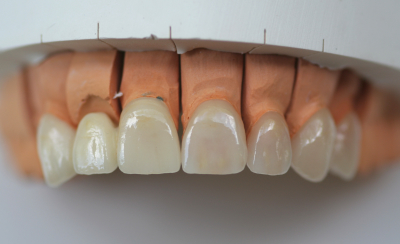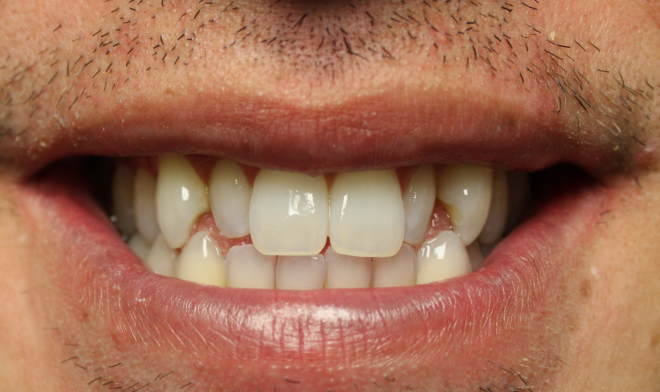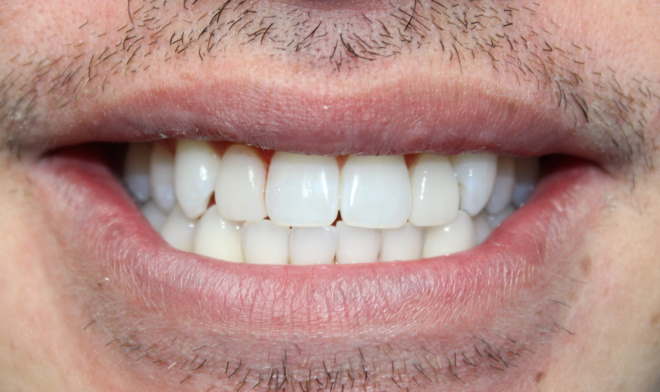 Dental veneers, or laminates, are paper-thin, but durable shells that are constructed mainly from porcelain but can also be constructed from resin composites. Often referred to porcelain laminates, ceramic sheaths, or porcelain veneers, they are long lasting, stain resistant and improve the appearance of the front surface of the teeth.
Dental veneers, or laminates, are paper-thin, but durable shells that are constructed mainly from porcelain but can also be constructed from resin composites. Often referred to porcelain laminates, ceramic sheaths, or porcelain veneers, they are long lasting, stain resistant and improve the appearance of the front surface of the teeth.
The thickness of each shell is only half a millimeter and to bond to the surface, an equal thickness has to be removed from the affected tooth. Porcelain, the primary material being used to make these laminates has a translucent property similar to a dental enamel and helps reflect the original tooth color of the patient. Porcelain itself is brittle so it relies on the strength of the underlying enamel.
Although veneers require a thin layer of enamel to be removed which can cause teeth sensitivity for a short time, the application is 100% safe and painless. Since its primary purpose is to improve the overall aesthetics of the teeth, dental veneers are recommended for a front tooth only. This procedure may not be useful in places where the teeth are not usually visible like the back molars. This is also not a solution for a missing or damaged tooth as such a case would require a dental implant, crown or overlay.
If you are looking to cover an entire teeth and not just the surface then consider dental implants which require dental crowns. Call us to make an appointment if you have more questions on what is best for you. The procedure usually involves two or three office visits to cover the consultation, making and application of the veneer. One tooth or multiple teeth can be simultaneously treated during the course of the procedure.
Dental laminates are mainly for cosmetic purposes. They are a great solution for many imperfections, such as shape and spacing irregularities that interfere with smile or chewing, for staining and others such as:
- Chipped, broken or cracked teeth – A crack or chipped tooth can be easily repaired and its looks restored.
- Gaps or spaces between teeth – Gaps between teeth can easily be solved. Veneers can be the right solution regardless of how small or big the gap may be.
- Discolored, stained or yellowed teeth – This is a common reason patients desire dental laminates. Teeth can be discolored due to a variety of reasons including hygiene, neglect, root canal treatment, gastric reflux, use of drugs, resin fillings, and more. Tobacco and alcohol can cause discoloration as well. It may be surprising, but too much fluoride can also cause discoloration.
- Irregularly shaped or misaligned teeth – Not everyone was born with an excellent set of teeth. Some can be misaligned or crooked from the start with unusual or unequal width or height. The surfaces may have depressions or bulges in the front. Laminates can be used to cover any of these problems.
- Uneven or excessively worn teeth – When teeth are worn down over time, the most common reason for that is neglect of oral hygiene. There are various factors that could cause the teeth to be eroded as well as fluoride deficiency, diabetes and even genetics.
Procedure & Application
The application of dental veneers can be more complex than other dental procedures because they are directly bonded to the teeth. The procedure has a few steps: Consultation and planning; preparation of the mouth and the creation of impressions; and the application itself. Usually, a patient will have two to three visits with our DDS until the procedure is complete, depending on whether the patient has also had a separate consultation visit.
Consultation and Planning – This will be first meeting of the patient with our cosmetic dentist. The patient will discuss their particular problems and any aesthetic desires. The dentist will do an exam and evaluation and discuss whether veneers are the best fit for the situation. For instance, if there is a bite issue, then it has to be attended first before going on with the procedure. The patient may also discuss other cosmetic and restorative procedures as well as the overall cost and expected healing time.
Preparation and Taking Impressions of the Patient’s teeth – The next visit contains two of the most crucial steps of the procedure:
Preparation – In this step, the dentist removes a layer of the enamel equal to that of the proposed laminate (more layer is removed for composites, less on porcelains) from the surface of the teeth. When the teeth are crowded or crooked, more materials need to be removed on the surface of the teeth and on the sides of the teeth as well. It is normal to experience pain and discomfort during due to the gums being bruised from the enamel trimming. The discomfort can last a few days but during this short time, the gums will heal and there is not much pain and discomfort after that. Any broken tooth would be restored before going on with the procedure.
Impressions – The dentist will prepare the impressions. The impressions and the material of choice are sent to the lab to be prepared. The lab then prepares the impressions according to the dentist’s instructions. The process could take from five up to ten days in which it overlaps the healing of the gums and ensures that it fits properly to the patient’s teeth.
Application – This is the final step and it happens after the impression is complete. The process would take about 10 days. The patient’s teeth will be cleaned, polished, chemically etched and the surface of the teeth roughened. This procedure will help improve the bonding process. This is then attached to the teeth using a transparent cement. If the surface is porcelain and is being applied to the discolored teeth, an opaque cement will be used to glue it on the teeth. The color of the cement will match the color of the adjacent teeth. After the successful application, the patient is asked to close the mouth and determine if the upper set of teeth fits properly and comfortably with the bottom part of the teeth.
- Before
- After
Our dentist may schedule another visit in several weeks to check the placement again. Cost estimates are specific to your situation. Please call to discuss the cost for dental veneers for your specific needs. We can even help you see what your insurance covers.
Fullerton, Orange County – Serving Our Neighbors
We would like to give you the beautiful smile you truly deserve. Whether it is dental veneers, teeth whitening, Invisalign or anything else related to your oral health. If you have any questions about these procedures or insurance, request an appointment at our OC practice in Fullerton, CA. We are just minutes away from Anaheim in our community of Orange County, California. Schedule an appointment today and live that better life!
Dental Veneers – FAQs
Porcelain veneers are designed to both look and feel as natural as real teeth. How well they match your tooth’s natural enamel will be heavily dependent upon factors like the shade of your teeth, the condition of your mouth and the skill of your dentist.
Some veneers may appear differently due to their width, thickness or form.
During the preparation, the dentist will grind away part of the tooth enamel to make room for the veneer. He will then make an impression of the tooth and send it to a laboratory that will make the veneer. A week or two later, he will fit the veneer to the tooth and then bond it to the tooth with a cement.



